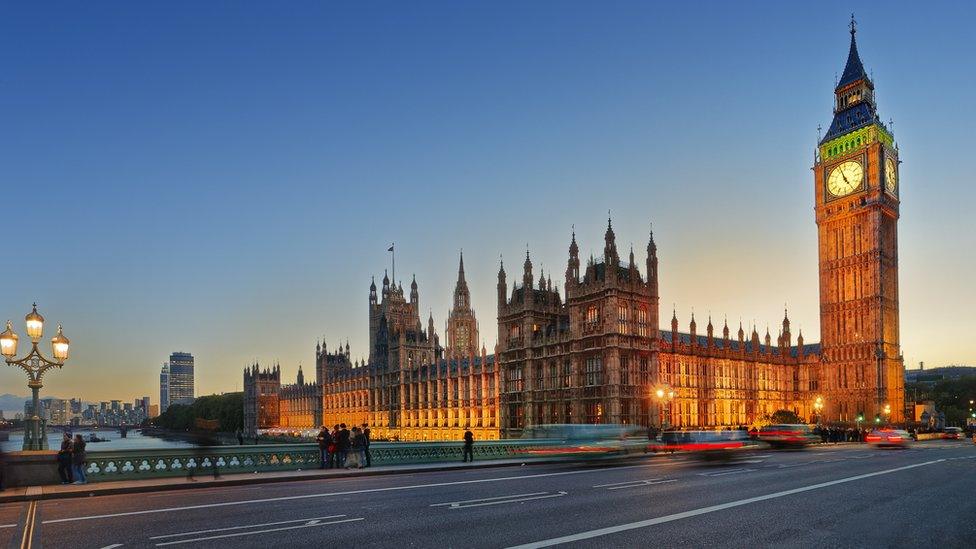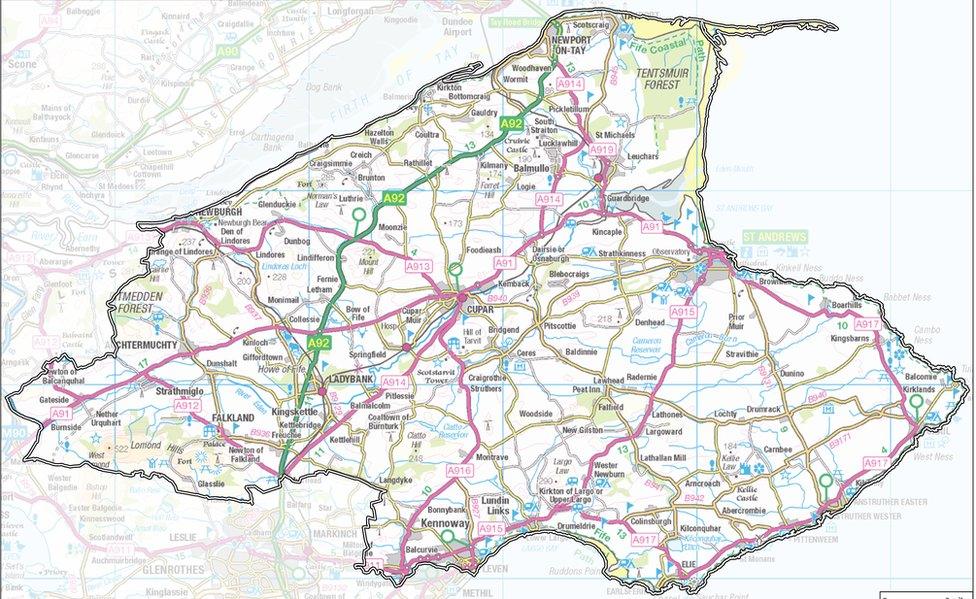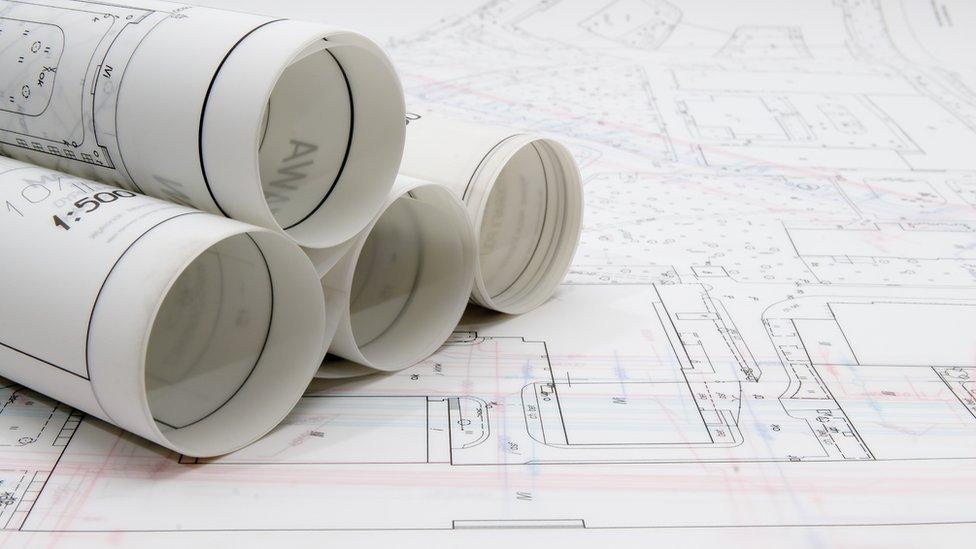How Scotland's new election map reshapes the race
- Published
- comments

The general election on 4 July will be the first contested under a new electoral map in Scotland and across the UK. Scotland will return two fewer MPs to the House of Commons as a result of the changes.
Why is this happening, and how could this new political geography affect the election?

Why is Scotland losing seats?
Constituency boundaries are reviewed across the UK on a fairly regular basis.
This is because the population grows at different rates in different parts of the country, and all MPs are meant to represent roughly the same number of constituents - within a 5% margin of 73,393, which is literally just the UK population divided by the number of constituencies.
The south east of England is now home to a larger proportion of the UK population, so it needs seven extra MPs.
Wales meanwhile accounts for a notably smaller share of the populace than it did, and is losing eight MPs. Scotland is losing two, going from 59 seats to 57.
All of this is based on simple arithmetic, and an independent commission in each part of the UK has drawn up the specific proposals for the new seats - so no, this is not part of some kind of gerrymandering conspiracy.

Each MP is meant to represent roughly the same number of constituents
Where are the biggest changes happening?
The changes within Scotland are widespread. Only ten constituencies will be unaffected - and for two of them in Orkney and Shetland and the western isles, it's because they are protected by law.
In some areas the changes are small; Edinburgh South West is gaining a single building, for the sake of matching up to local authority ward boundaries.
But in some places the alterations cover great swathes of land and indeed voters. The Highland seat of Caithness, Sutherland and Easter Ross now covers just shy of 12,000 square kilometers, having swallowed up Dingwall and Ullapool in a bid to reach the quota of voters.
The Highlands is also the former home of one of the "disappearing" seats - part of big changes made across Inverness, Moray and western Aberdeenshire
The other is coming out of Glasgow, with the old Glasgow Central constituency being broken up and parcelled out among the surrounding city seats.

The new map of seats around Glasgow - with council areas outlined in red
The Scottish boundary commissioners ran through a series of consultations to try to carve up the map into suitably-sized chunks, while remaining sensitive to existing communities.
To illustrate the kind of issues facing them, the old Falkirk seat had grown far too large, with 86,183 voters. But proposals to chop off neighbouring Denny to bring the numbers down towards the quota target proved unpopular.
What we have ended up with is Grangemouth and Stenhousemuir being shunted off into a strangely-shaped seat with Alloa, across the other side of the River Forth - but without a bridge in between.
Some of the solutions may seem unusual, but they reflect the highly complicated task which confronted the commissioners.
How does this change the context for the 2024 election?
Talking of complicated...
Because the makeup of the electoral map is different, we need to think slightly differently about the coming general election.
To start with, the numbers would look weird if we were comparing an election for 57 seats to one with 59. And then there's the "movement" of voters - whole communities of them - into different constituencies.
So the baseline for this contest in terms of gains and losses is not the 2019 result, but the "notional" result using the new boundaries.
Boffins have used ward-level data to work out how the results would have looked that year, if it had been fought on the current map of 57 seats.
In many places this doesn't make a big difference. Bits of SNP-held seats have joined bits of other SNP-held seats, so at the end of the day we still think of them as seats the SNP is defending. But it's not always so simple.
Take North East Fife, which the Lib Dems narrowly took from the SNP in 2019.

New boundaries have added in the village of Kennoway to the south - and the extra wards are enough to tip the overall result for the seat over to the SNP.
Had these boundaries been used in 2019, the data says the SNP would have won, so for the purposes of this campaign they are treated as the incumbents.
This will feel quite strange on election night. If the MP who held the seat when parliament was dissolved - Wendy Chamberlain - returns there, it will go down as a Lib Dem gain. And if the SNP retake the seat, it will officially be a "hold".
A more complicated example is Gordon and Buchan. The SNP retook the old Gordon seat from the Tories in 2019.
But the new seat has lost some more SNP-friendly wards to the south, and gained some more Conservative-leaning ones to the north, and when you add up the totals it means the new seat is actually considered a Tory one.

What does this mean for election night?
Despite the changes, other shifts which have taken place in the interim are not reflected in the baseline for 2024.
The Rutherglen and Hamilton West by-election, which was won by Labour's Michael Shanks last year, will have an impact in terms of momentum and the political narrative.
But the Rutherglen seat he is now contesting will officially be an SNP defence. His returning by-election rival Katy Loudon will find she has "held" it if she wins at the second time of asking.
Defections are also wiped away; so the two seats occupied by the Alba Party at prorogation are officially SNP defences, as is Lisa Cameron's former East Kilbride seat, despite her defection to the Tories.
The notional seat totals for the parties are SNP 48, Conservative six, Lib Dems two, Labour one.
Again this might feel odd on the night - the Lib Dems could return the same four MPs to Westminster, but officially double their representation from two.
Many people may find themselves with a new MP regardless of how voting goes in their local area - because the boundaries have moved around them.
So it's worth getting to grips with the changes and their implications now.